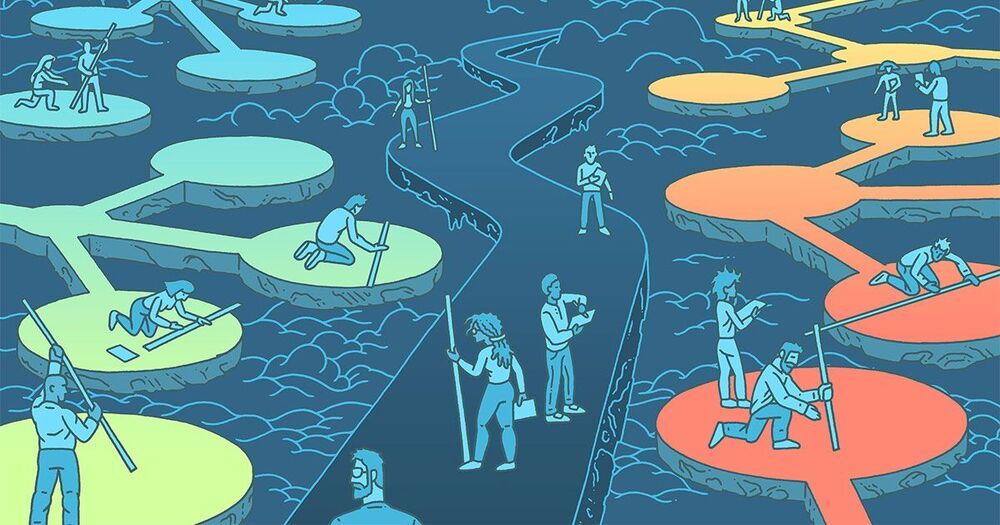Three reasons why it falls short.
Isaac Newton invented physics as we know it. And one of the ways he did so was that he formalized the initial condition problem into calculus — the mathematics of change.


Researchers from Skoltech, KTH Royal Institute of Technology, and Uppsala University have predicted the existence of antichiral ferromagnetism, a nontrivial property of some magnetic crystals that opens the door to a variety of new magnetic phenomena. The paper was published in the journal Physical Review B.
Chirality, or handedness, is an extremely important fundamental property of objects in many fields of physics, mathematics, chemistry and biology; a chiral object cannot be superimposed on its mirror image in any way. The simplest chiral objects are human hands, hence the term itself. The opposite of chiral is achiral: a circle or a square are simple achiral objects.
Chirality can be applied to much more complex entities; for instance, competing internal interactions in a magnetic system can lead to the appearance of periodic magnetic textures in the structure that differ from their mirror images—this is called chiral ferromagnetic ordering. Chiral crystals are widely considered promising candidates for magnetic data storage and processing device realization as information can be encoded via their nontrivial magnetic textures.

A team of Swiss researchers from Graubuenden University of Applied Sciences has broken the record for calculating the mathematical constant pi. It is now known to an incredible level of exactitude, hitting 62.8 trillion figures thanks to the work of a supercomputer.
Pi represents the ratio between the radius of a circle and its circumference. You may recognize the first 10 digits, π=3.141592653, though there is an infinite number of digits that follow that decimal point.
To write all of the digits for the new record out on A4 paper, you would need almost 35 billion sheets, equivalent to about 52 percent of the mass of the Empire State Building. Putting those pieces of paper head to toe they would extend for over 10 million kilometers (6.5 million miles).

Summary: Study reveals how the brain analyzes different types of speech which may be linked to how we comprehend sentences and calculate mathematical equations.
Source: SfN
Separate math and language networks segregate naturally when listeners pay attention to one type over the other, according to research recently published in Journal of Neuroscience.

Determining if particular extreme hot or cold spells were caused by climate change could be made easier by a new mathematical method.
The statistical method, developed by physicists at the University of Reading and Uppsala University in Sweden, looks at the characteristics, or “fingerprints,” of a specific extreme weather event of interest, like a heatwave, in order to ascertain whether it can be attributed to natural climate variability of the climate or is a unique product of global warming.
The method also allows predictions to be made about how likely extreme climate events will be in the future.

According to findings published in Learning and Individual Differences, a secure bond between father and child is particularly important for children’s development of coping skills related to mathematics. The longitudinal study found that the father-child bond predicted children’s math anxiety one year later, while the mother-child bond did not.
The term “math anxiety” is used to describe fear and apprehension surrounding math and can occur in children and adults alike. Math anxiety can arise in response to any situation that requires mathematics — from solving a math problem at school to calculating the tip at a restaurant.
Previous studies have uncovered parental factors that play a role in the development of math anxiety among children — for example, parents’ use of math at home with their children. There is also evidence that that the quality of the parent-child relationship influences math anxiety among children, but until now, no study had teased apart the specific roles of the mother-child versus father-child bond.

Houston-based ThirdAI, a company building tools to speed up deep learning technology without the need for specialized hardware like graphics processing units, brought in $6 million in seed funding.
Neotribe Ventures, Cervin Ventures and Firebolt Ventures co-led the investment, which will be used to hire additional employees and invest in computing resources, Anshumali Shrivastava, Third AI co-founder and CEO, told TechCrunch.
Shrivastava, who has a mathematics background, was always interested in artificial intelligence and machine learning, especially rethinking how AI could be developed in a more efficient manner. It was when he was at Rice University that he looked into how to make that work for deep learning. He started ThirdAI in April with some Rice graduate students.

Mathematicians have proved that a geometric object called the Fargues-Fontaine curve can connect arithmetic and geometry. The work is a major advance in one of the most ambitious projects in mathematics.
The grandest project in mathematics has received a rare gift, in the form of a mammoth 350-page paper posted in February that will change the way researchers around the world investigate some of the field’s deepest questions. The work fashions a new geometric object that fulfills a bold, once fanciful dream about the relationship between geometry and numbers.
“This truly opens up a tremendous amount of possibilities. Their methods and constructions are so new they’re just waiting to be explored,” said Tasho Kaletha of the University of Michigan.
The work is a collaboration between Laurent Fargues of the Institute of Mathematics of Jussieu in Paris and Peter Scholze of the University of Bonn. It opens a new front in the long-running “Langlands program,” which seeks to link disparate branches of mathematics — like calculus and geometry — to answer some of the most fundamental questions about numbers.

Summary: Combining artificial intelligence, mathematical modeling, and brain imaging data, researchers shed light on the neural processes that occur when people use mental abstraction.
Source: UCL
By using a combination of mathematical modeling, machine learning and brain imaging technology, researchers have discovered what happens in the brain when people use mental abstractions.